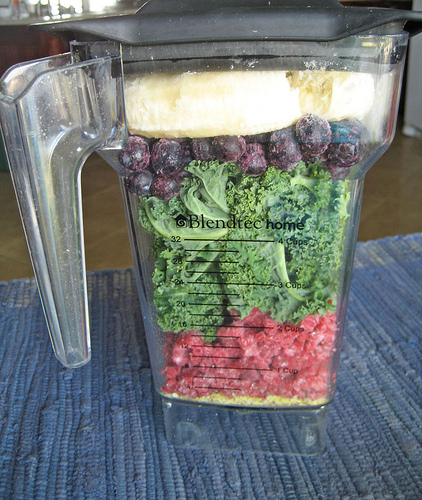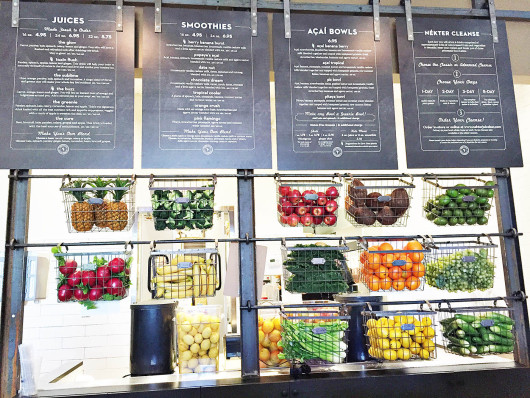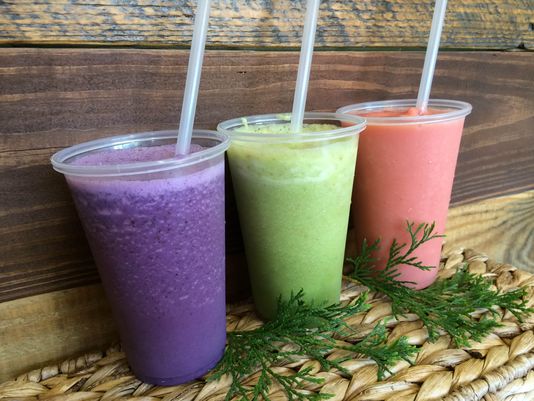In theory, meal prepping sounds like a no-brainer – look at your week ahead and plan accordingly.
And while it all checks out on paper, meal prep planning fails to take into account the unexpected. There are some weeks you are busier then others, some days where you’re traveling and can’t bring food (or you forget!) and other days you have to meet someone for dinner.
Eating out doesn’t mean you’re doomed to settle for an unhealthy option. There are plenty of healthy options in our local community. This next month, Elite will spotlight several local restaurants around Chandler/Tempe so you can always have a fresh meal option in your back pocket! This week we’re looking at how to build a healthy smoothie or juice; plus guide to popular smoothie add-ins.
When you walk up to a smoothie bar, you can feel good about the choice you’re making, right? Well, it depends. Smoothies can be a bit mysterious.
Today’s juice bars have turned making a smoothie into a science experiment. Toss in a dash of something for extra vitamins, build muscle with a pinch of something else, or take a shot for an energy boost. The simple days of banana and peanut butter are long gone.
The problem with blended drinks is the fact that you may not know what or how much of any ingredient goes into your drink. Plus, the atmosphere, signage, and menus at the smoothie bar can be deceiving. Terms like ‘all natural,’ ‘light,’ and ‘lightly sweetened,’ tell us nothing about ingredients or nutritional value.
A smoothie still can be a healthy choice. Read on for tips on how to get the most nutritious — and least caloric — bang for your buck at the smoothie line.
5 Tips to pick the perfect smoothie
1. Keep calories in mind.
Look for one around 400 calories, with at least 10 grams of protein and 5 grams of fiber, if you’re replacing a meal. If the smoothie is just a snack, pick the smallest size possible and try to stay under 200 calories total.
2. Keep dairy low-fat.
Opt for plain yogurt because fruit-flavored yogurt adds extra calories and sugar. Soy milk or almond milk is a healthful choice but avoid using ice cream or even frozen yogurt, which does not equal regular yogurt in terms of nutrition.
Smoothie boosters are designed to help you push your body a bit further. Read this guide before your next visit to the juice bar to learn exactly what those strangely named ingredients actually do for you.
3. Skip fruit juice.
One or more fruits — think blueberries, raspberries, cherries, bananas, apples — are great for packing vitamins, antioxidants, and fiber into your smoothie, but always choose whole fruits over their fruit juice counterparts. Many smoothie bars use fruit juice rather than fresh fruit, which means a lot of nutrients and most or all of the fiber from the original whole fruit is gone,
4. Watch your sugar.
Anything with syrup is going to mean excess sugar and calories. Most likely, you’re not going to need additional sweeteners. The fruit you pick is going to make it sweet enough. Remember that fructose, the sugar found in fruit, is still sugar. One smoothie can contain as many as six servings of fruit, providing the same amount of sugar as a can of Coke, and as many carbs as six slices of bread.
5. Be careful with supplements.
Aim to get the nutrition in your smoothie from foods rather than the supplement powder options commonly offered. Most of these powders are not regulated by the FDA. They could say it’s a metabolism-boosting or muscle-building powder, but none of those claims are regulated.
Ever wonder about those mystery add-ins? Smoothie boosters are designed to help you push your body a bit further. Read below before your next visit to the juice bar to learn exactly what those strangely named ingredients actually do for you.
7 Popular Smoothie Boosters Explained
1. Ginseng
Frequently found in energy-boosting supplements, ginseng affects the brain’s hormone receptors by stimulating the secretion of the adrenal hormone. These are the hormones involved in emotion, stress and, as the name suggests, adrenaline. Opinions on whether ginseng improves athletic performance are mixed; however, recent studies have found that it doesn’t do much to boost strength or endurance during exercise. (1)
2. Wheat grass
Wheat grass is exactly what it sounds like. It’s the grass of a wheat plant. It’s not fancy, but its effects on the body are. The major ingredient in wheat grass is chlorophyll, a green pigment that improves the body’s ability to draw toxins out of the bloodstream. (2) Detoxifying the body promotes healthy blood and normalizes the thyroid gland, which is essential for regulating metabolism. When the thyroid doesn’t function properly, it can affect everything from weight to depression to energy levels. (3) (Learn more in Iodine: An Overlooked Essential Mineral.)
3. Maca Powder
Before blenders and ice machines, Incan warriors took maca to boost their strength and endurance. Consider them the first Peruvian smoothie bars. Maca is actually a rare herb known as an “adaptogen.” Such herbs control the body’s response systems that deal with stress, anxiety and fatigue. So Maca could potentially increase your motivation on days when you don’t feel like hitting the gym. (4)
4. Coconut
Due to coconut’s high levels of saturated fat, nutritionists used to caution against consuming too much of the fruit. So why the recent change? Scientists discovered that coconut is composed mainly of medium-chain triglycerides, a easily digestible form of saturated fat. Medium-chain fatty acids may not carry the same risks as other kinds of saturated fats found in butter and most other oils, which are long-chain fatty acids. (6) Coconut is also one of the highest natural sources of electrolytes. New research has proven that coconut water offers similar rehydration benefits as water and sports drinks.
5. Acai and Goji Berries
Goji berries are a bright orange-red berry packed full of carotenoids beta-carotene and zeaxanthin. The Acai berry is a bright blue berry with extremely high levels of anthocyanins. Both have been linked to helping clear acne, protecting the immune system, reducing body aches and lowering blood cholesterol and triglycerides.
6. Flaxseed or Chia Seeds
Servings of ground flaxseed or chia seeds contain 4 grams of fiber, 2.4 grams of the essential omega-3 fatty acid alpha-linoleic acid (ALA), and 300 milligrams of lignans. Both ALA and lignans are anti-inflammatories, which help reduce soreness after a workout. Recent studies have found that consuming three tablespoons per day of lignans can lower cholesterol. (11)
The difference between the two is that chia seeds can be consumed whole, whereas flax seeds must be ground first. Another big difference is that when chia is exposed to water, it forms a gel that grows in size and weight in your stomach, promoting fullness. (12)
7. Spirulina
Spirulina sounds like the name of some mythical sea creature. Although the micro-algae isn’t nearly as cool as its name suggests, you will find it floating around in the ocean depths. A 70% complete protein, spirulina contains seven of the 10 essential amino acids and 10 of the 11 non-essentials. (13) Spirulina promotes muscle repair after a tough weight session. It is easily digestible and has been shown to protect the immune system, help reduce cholesterol, and control blood sugar levels. (14)(15)




